AERO 201 Midterm Review
1/109
There's no tags or description
Looks like no tags are added yet.
Name | Mastery | Learn | Test | Matching | Spaced |
|---|
No study sessions yet.
110 Terms
What is a fluid?
A fluid is a substance which cannot resist an applied shear stress.
What are the two types of fluids?
Liquid: Incompressible and cannot change density
Gas: Compressible and can change density
What are the four fundamental quantities of a fluid that we will use in aerodynamics?
Pressure (p), Temperature (T), Density (ρ), and Velocity (v)
What is Pressure?
Pressure, defined by the lowercase p, is the normal force per unit area exerted on a surface due to the time rate of change of momentum of the gas molecule impacting on the surface.
Pressure is usually defined at a point in the gas and can vary from one point to another.
p = lim dA → 0(df/dA)
Units for Pressure: N/m², lbf/ft²,
What is Density?
Density, defined by lowercase rho ρ, is mass of a substance per unit volume.
Density can also be defined as a point property and can vary from point to point.
ρ = limdV→0(dm/dV)
Units for Density: Kg/m³, slug/ft³
What is Temperature?
Temperature, defined by uppercase T, is the measure of the average kinetic energy of particles in the gas.
If KE is the mean molecular kinetic energy, then: KE = (3/2) kT
Here, k is the Boltzmann constant: k=1.38×10-23 J/K
Units for Temperature: Celsius, Rankine, Fahrenheit
What is Velocity?
Velocity is, denoted by lowercase v or sometimes uppercase V, at any fixed point B in a flowing gas is the velocity of an infinitesimally small fluid element as it sweeps through B.
Velocity is a point property and can vary from point to point in the flow.
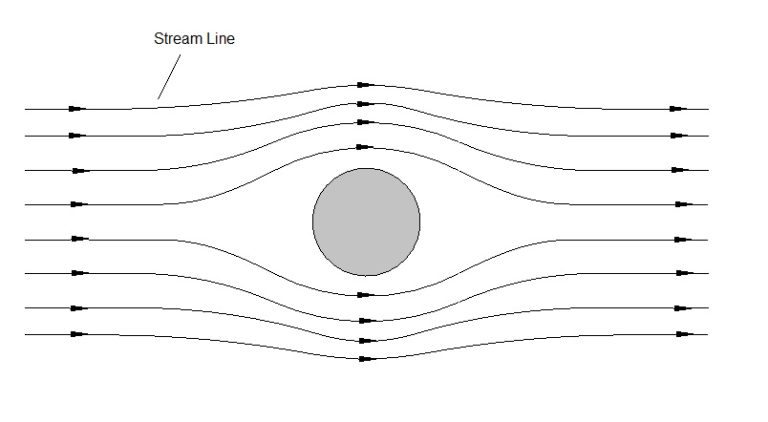
What are Streamlines?
When flow is steady (i.e. does not change with time), the moving elements make fixed paths in space called Streamlines.
What is a Flow Field?
The Flow Field is defined by the pressure, density, temperature, and velocity at each point.
What is a Perfect Gas?
A perfect gas is one in which intermolecular forces are negligible.
A gas in nature where the particles are widely separated (low density) can be approximated as a perfect gas.
What is the assumption do we make, about air, when using Equation of State for a Perfect Gas?
It is reasonable to assume that air at standard conditions and about subsonic or supersonic flights is a perfect gas.
Equation of State for a Perfect Gas
The relationship between pressure, density, and temperature is called the Equation of State.
For a perfect gas it is: p = ρRT
Where R is the specific gas constant that varies from one gas to another.
For air: R = 287 J/Kg*K = 1716 ft*lbf/slug*R
What is Specific Volume
Specific Volume, defined by a lowercase squiggly 𝑣, is the inverse of density and is defined as the volume per unit mass.
𝑣 = 1/ ρ
V = m𝑣
Units for Specific Volume: m³/kg, ft³/lbm
Which Two Sources does the Aerodynamic Force exerted by the airflow on a surface stem from?
Pressure distribution on the surface
Shear stress (friction) distribution on the surface
Once we know the pressure and shear stress distributions on a surface (i.e. an airfoil), we can measure the aerodynamic forces on the surface.
What forces aid in flight?
Lift, Drag, Thrust, Weight
What Aerodynamic forces aid in flight?
Lift and Drag are our two Aerodynamic forces that aid flight.
What is Shear Stress?
Shear Stress, denoted by 𝜏w, is defined as the force per unit area acting tangentially on a surface due to friction.
Δp = ΔFn/ΔS
Δ𝜏w = ΔFT/ΔS
Static Condition on an airfoil is when pupper = plower. Why is this an important observation?
If the pressureupper = pressurelower on an airfoil/wing, that means that there will be no resultant net force.
Dynamic Conditions occur most commonly when pupper < plower. Why is this an important observation?
If pressureupper = pressurelower on an airfoil/wing, that means the airfoil/wing is not static and lift occurs in the situation where lower > upper.
What is the Coefficient of Lift for a finite wing?
CL = (L) / (1/2ρv² * S)
Note:
CL denotes Coefficient of Lift for a finite wing, while a lower case l (Cl) would represent an infinite wing.
(v) represents the velocity
(S) represents the wing area
(L) represents the Lift force
(ρ) represents the density
Dynamic pressure (q-bar) is equal to (1/2ρv²), so another form of this equation can be represented as:
CL = (L) / ((q-bar) * S)
What is the equation for Dynamic Pressure?
(q-bar) = 1/2ρv²
Note:
(ρ) represents density
(v) represents velocity
Where does lift come from?
Lift occurs when a moving flow of fluid is turned by a solid object.
The flow is turned in one direction, and the lift is generated in the opposite direction (Newton’s 3rd Law)
Any solid surface can deflect a flow
On an aircraft wing, both the upper and lower surfaces contribute to the flow turning
If there is no fluid, what happens to the lift?
If there is no fluid (liquid, gas), there will be no lift. There must be a solid body to interact with a fluid for lift to occur.
If there is no motion, what happens to the lift?
If there is no motion, there is no lift. Lift is generated by the difference in velocity between the solid body and the fluid.
Lift acts perpendicular to the motion (perpendicular to the velocity)
Drag acts in the direction opposite to the motion
What is a fuselage?
The fuselage is the tube/main structure of the aircraft that carries people, cargo, and other payload.
What is a nose gear?
The nose gear is located at the front of an aircraft and is used for steering when on the ground.
What is a nacelle?
The nacelle encloses the engine.
What is the main landing gear?
The main landing gear if often located near the belly of the aircraft. It aids in supporting the aircraft’s weight on the ground.
What is the vertical stabilizer?
It is located at the back of the plane, near the tail. It aids in Yaw Stability.
What is a rudder?
The rudder is located at the back of the plane, connected to the vertical stabilizer. The rudder provides Yaw Control.
What is a horizontal stabilizer?
The horizontal stabilizer is located at the back of the plane. It provides Pitch Stability.
What is a wing, when referring to aircraft anatomy.
A wing on an aircraft provides lift.
What is an aileron?
The ailerons are attached to the wings. They provide Roll Control.
What are slats?
Slats aid in take-offs and landings by increasing/decreasing the wing area to adjust lift and drag.
What are winglets?
Winglets are attached to the end of a wing. They reduce drag.
What are spoilers?
Spoilers are on the wing. Spoilers flip up on a wing, where they reduce lift and increase drag.
What is an elevator?
The elevator is located at the tail of a plane. They are attached to the horizontal stabilizer. They provide Pitch Control.
What is Aircraft Yaw?
Yaw is about the vertical axis.
The rudder controls the yawing motion.
The rudder, and thus the yaw, is controlled by the rudder pedals.
What is Aircraft Pitch?
Pitch is about the lateral axis.
Elevators control the pitching motion.
The yoke controls the elevators, thus controlling the pitch, by pulling up or pushing down.
What is Aircraft Roll?
Roll is about the longitudinal axis.
The ailerons control the rolling motion.
The yoke controls the ailerons, and thus the roll, by turning left and right.
What are the different layers of the atmosphere?
Note:
Gradients end with -sphere
temperature in these region changes linearly with altitude
Isothermal regions end with -pause
“pause” since temperature is not changing drastically, so we consider these regions to have a constant temperature
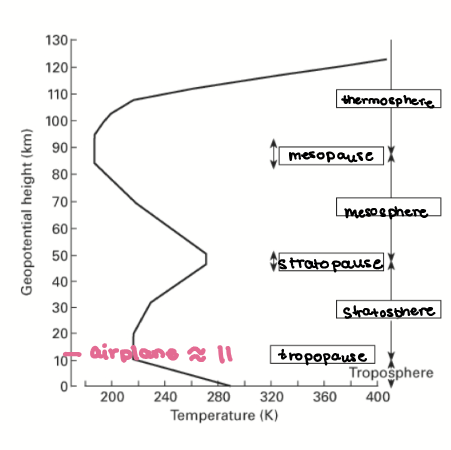
What is geometric altitude?
(hG): the geometric height above sea level
What is absolute altitude?
(ha): height measure from the center of the earth
What is the relationship between geometric altitude and absolute altitude?
ha = hG + r
Note:
( r ) represents the radius of the earth

What is the relationship between (go): acceleration due to gravity at sea level, (ha): absolute altitude, (g): Newton’s law of gravitation, and (hG): geometric altitude?

What is the Hydrostatic Equation?
dp = -ρdhGg
if we simplify by assuming g = go= constant then it becomes:
dp = -ρgodh where (h) represents a fictitious geopotential altitude
What is the relationship between the geopotential altitude (h) and the geometric altitudes (hG)?
h = [ r / (r + hG) ]hG
What is an isothermal region?
Those where temperature is constant.
What is the pressure ratio for an isothermal region?

What is the density ratio for an isothermal region?

What are gradient regions?
In gradient regions, temperature varies linearly with altitude.
What is the lapse rate (a).
a = dT/dH = (T2 - T1) / (h2 - h1)
(a) is the lapse rate which constant over a specific gradient layer.
What is an equation for T when it varies linearly with altitude?
T = T1 + a ( h2 - h1)
What is the pressure ratio for the gradient region?

What is the density ratio for the gradient region?

How do you derive the isothermal ratio equations for density and pressure?
Divide the Hydrostatic Equation with the Equation of State
Integrate over altitude
How do you derive the gradient ratio equations for density and pressure?
Temperature varies linearly with lapse rate
a = dT/dh
Divide the Hydrostatic Equation with the Equation of State
Integrate over Temperature
What is the equation for the speed of sound?
a = sqrt(γRT)
where (a) represents the speed of sound
(γ) represents a constant, for air it is γ = 1.4
(R) is the universal gas constant
(T) is the temperature
Name the four types of aerodynamic flows we deal with.
Inviscid Flow: Flow with no friction
Viscous Flow: Flow with friction
Compressible Flow: flow in which the density of the fluid of the element changes from one point to another
Incompressible flow: flow in which the density of the fluid is constant
In which occasions can we assume flow is incompressible for?
Liquids
Low speed air flow, (M < 0.3)
When can the Continuity Equation be used? What are the assumptions we make?
The Continuity Equation is using the principle that mass is conserved. It is applicable to inviscid and viscous flows.
We make the assumptions that:
The flow is steady/time invariant
Velocity and density are uniform across each cross section
What is the mass flow rate?

the mass flow rate through an area A is the mass crossing A per unit time. units: kg/s, slugs/s.
dm/dt = mass flow rate = ρAv
where (ρ) is density
(A) is area
and (v) is velocity
What is the Continuity Equation for a steady fluid flow?
ρ1A1v1 = ρ2A2v2
where (ρ) is density
(A) is area
and (v) is velocity. This is applicable to both compressible and incompressible flows.
What is the Continuity Equation when the flow is incompressible?
Since density cannot change in an incompressible flow, (ρ1 = ρ2), then the Continuity Equation simplifies to:
A1v1 = A2v2
What flow can the Momentum Equation (Euler’s and Bernoulli’s) be applied to?
Only applicable to Inviscid Flows.
What is Euler’s equation, otherwise known as the momentum equation?
dp = -ρVdV
Euler’s equation is a differential equation. Integrating Euler’s equation between two points will give us Bernoulli’s Equation.
What are the assumptions when using Euler’s equation, otherwise known as the momentum equation?
We neglect friction, as this is only applicable to Inviscid Flows
Consider a steady flow/ time invariant flow
What is Bernoulli’s Equation? What are the steps taken to derive it?
p + (ρV²/2) = constant along a stream line
We derive the Bernoulli’s Equation by:
Starting with Euler’s Equation: dp = -ρVdV
Integrating from point 1 to point 2
Assume the flow is incompressible, thus density may be taken out the integral
What assumptions should be used when applying Bernoulli’s Equation?
Bernoulli’s equation should only be applied to inviscid, incompressible flows!
Should NOT be applied to compressible flows!!!
How are static pressure, dynamic pressure, and total pressure related?
total pressure should always be greater than the static pressure.

What is a pitot-static probe used for?
This device is used to measure the static pressure and the total pressure.

What is the equation for true airspeed versus equivalent airspeed?
They can be derived from the total pressure equation.
True Velocity is found using the density at the corresponding altitude while Equivalent velocity is found using the density at sea level.

How do you calculate the Mach number?
v/a = M
where (v) is the velocity
and (a) is the speed of sound
(M) is Mach
What are the three forms of the First Law of Thermodynamics?

What is the specific heat ( c ) ?
Specific heat ( c ) is the heat added per unit change in temperature of the system.

For a constant volume process, what is the internal energy per unit mass (e)?
Holds true for any perfect gas.
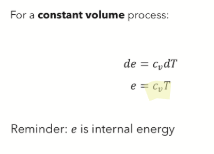
For a constant pressure process, what is the enthalpy per unit mass?
Holds true for any perfect gas.
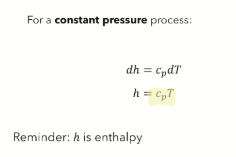
What is an isentropic process?
An isentropic process is one that is both adiabatic (no heat added or taken away, change in q = 0 ) and reversable (no frictional forces or other dissipative effects occur).
This is only relevant for compressible flows.
What is the leading edge on an aircraft wing?
The most forward point of the mean camber line.
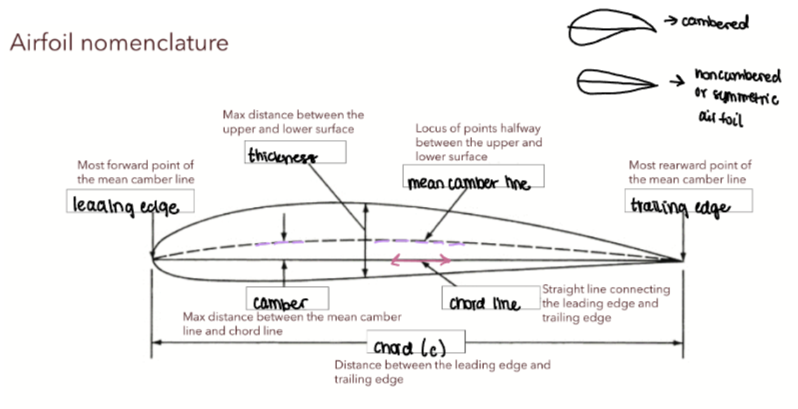
What is thickness on an aircraft wing?
The maximum distance between the upper and lower surface.
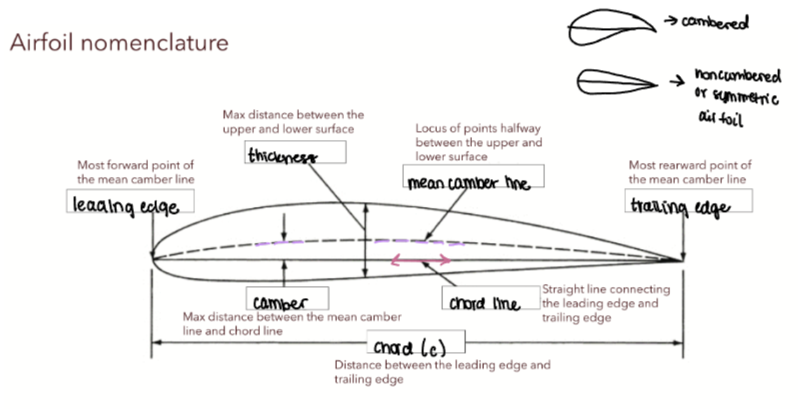
What is the camber on an aircraft wing?
The camber is the maximum distance between the mean chamber line and the chord line.
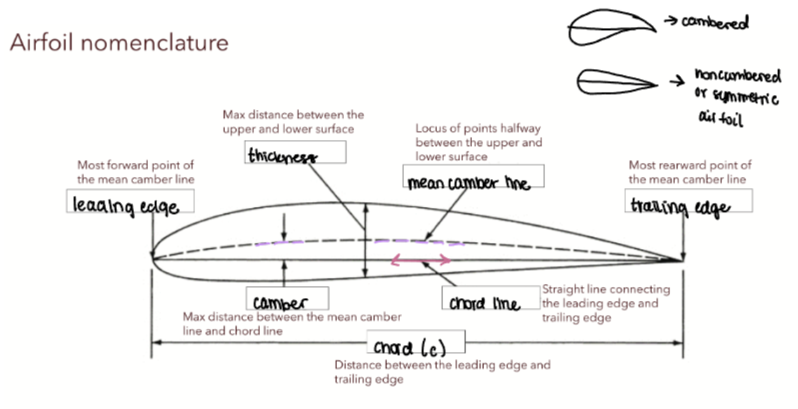
What is the mean camber line on an aircraft wing?
The mean chamber line is the locus of points halfway between the upper and lower surface.
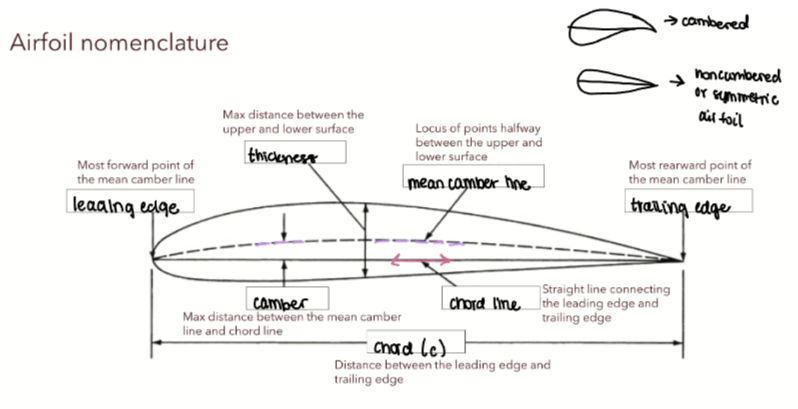
What is the chord line on an aircraft wing?
The chords line is the straight line connecting the leading edge to the trailing edge.
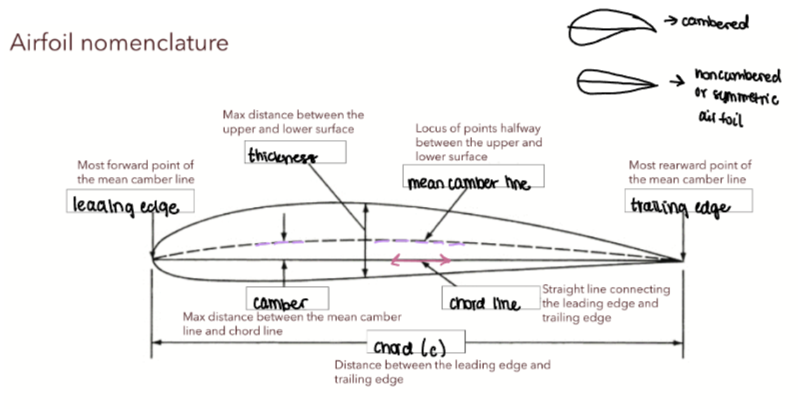
What is the chord ( c ) on an aircraft wing?
The chord is the distance between the leading edge and the trailing edge.
Note: no note mistake with the chord line
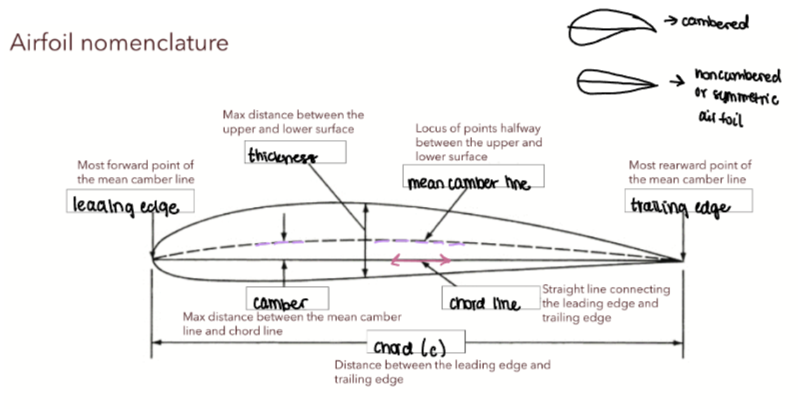
What is the trailing edge on an aircraft wing?
The trailing edge is the most rearward point of the mean camber line.
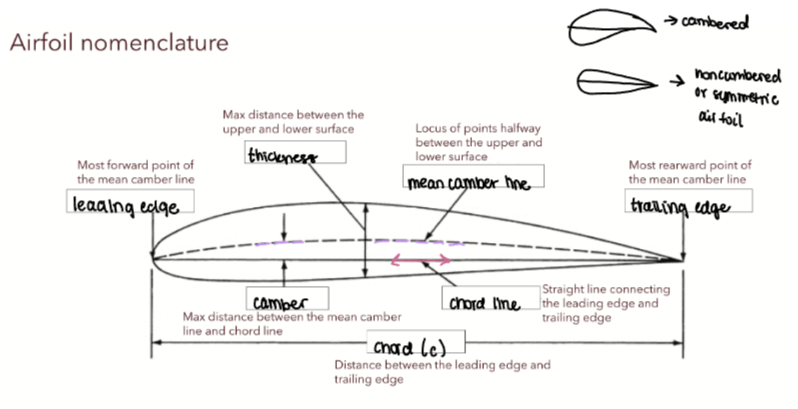
For NACA Airfoils, what do the placement of the digits mean for a Four Digit NACA Airfoil?
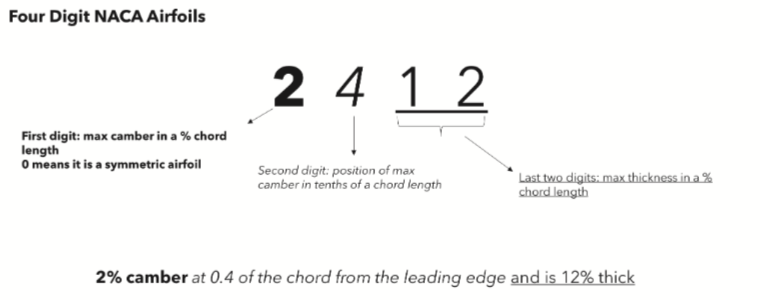
For NACA Airfoils, what do the placement of the digits mean for a Five Digit NACA Airfoil?
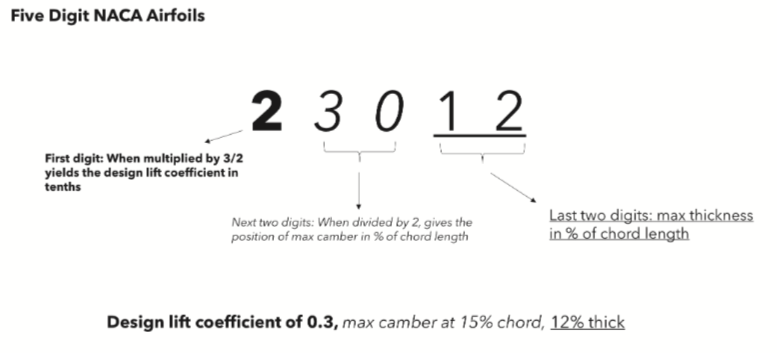
What is the angle between the relative wind and the chord line?
The angle of attack, denoted by (α).
Note: must have free stream velocity.
What is the equation for Lift using forces on an airfoil?
Lift = Ncos(α) - Asin(α)
Notes:
Lift is component of R perpendicular to V (free stream velocity)
where (α) is the angle of attack
(N) is the normal force that gives pressure
(A) is the Axial/Tangential force that gives shear stress
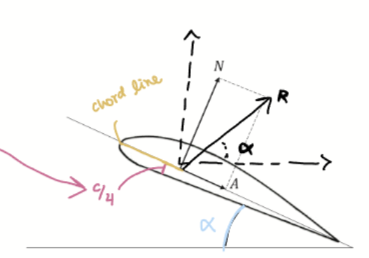
What is the equation for Drag using forces on an airfoil?
Drag = Nsin(α) + Acos(α)
Notes:
Drag is the component of R parallel to V (free stream velocity)
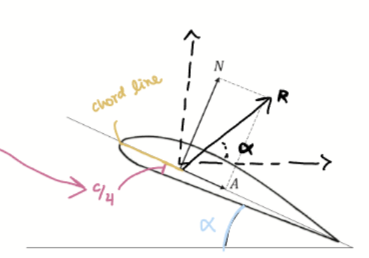
What is the Moment?
Moment (M) is usually about the quarter-chord, but its magnitude depends on the point about which moment is determined. Forces on the airfoil generate moment, which causes rotation.
(ex. About the leading edge: MLE, About the quarter-chord: Mc/4).
What is the aerodynamic center?
The moment is a function of the angle of attack, however, there is one point about which the moment does not vary with the angle of attack. This point is called the aerodynamic center.
The aerodynamic center can be determined experimentally.
For low-subsonic airfoils, it can be found close to the quarter-chord.
What occurs to lift when the Area (S) of the aerodynamic surface increases?
The more surface area means the more lift generated.
What does more camber mean for lift?
More camber means more lift. (pressure distribution)
What happens to lift if the free stream velocity is faster?
If we go faster, we generate more lift.
If the air is denser, what happens to life?
The denser air is, the more lift is generated.
If the angle of attack is increased, what happens to lift?
With a larger angle of attack, more lift is generated.
What is the function of the coefficient of lift for an infinite airfoil.
Cl = f ( α, μ , Re)
Note:
the lowercase l on the coefficient of lift means that this coefficient is for an infinite airfoil.
What is the equation for moment of an infinite airfoil?
M = ½ ρV²SCmc
What is the equation for drag of an infinite airfoil?
D = ½ ρV²SCd